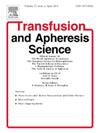用于治疗免疫介导的神经系统疾病的采血程序的数量正在上升
IF 1.2
4区 医学
Q4 HEMATOLOGY
引用次数: 0
摘要
离心分离法用于治疗许多不同的疾病,特别是在常规治疗无效的情况下。然而,在一些疾病中,采血被接受为一线治疗。本分析的目的是调查采血治疗神经系统疾病的使用情况,以及世界采血协会登记20年来的变化。2003-2023年期间,共对2963名神经系统疾病患者进行了23,699次采血手术。44个中心在不同时期收集数据,其中22个中心在最近10年内连续登记。在此期间发生的神经系统疾病的比例有所增加(p <; 0.001),而整体采血程序保持稳定(p = 0.46)。大多数手术是由于重症肌无力(MG;n = 11,049例(占患者的31% %),吉兰-巴罗综合征(GBS;n = 3247(30 %),多发性硬化(MS;n = 2665(18 %)),慢性炎症性脱髓鞘性多神经根神经病变(CIDP;n = 2367(3 %)),视神经脊髓炎(NMO;n = 650(2 %))。随着时间的推移,这些疾病的比例发生了变化。不良事件(ae)在两种疾病之间差异显著。GBS患者中、重度不良事件发生率最高。低血压是最常见的严重AE。不同的神经系统疾病可能会引起不同的ae,这是基于神经系统对采血程序和替代液的反应的差异。重要的是要在开处方者和采血者之间扩大这方面的知识。本文章由计算机程序翻译,如有差异,请以英文原文为准。
The number of apheresis procedures to treat immune-mediated neurological diseases is on the rise
Apheresis is used for the treatment of many different diseases, especially when conventional therapy lacks efficacy. There are however some diseases in which apheresis is accepted as first line therapy. The aim of this analysis was to investigate the use of apheresis for the treatment of neurological diseases and the changes over two decades in the World Apheresis Association registry. During the period 2003–2023, a total of 23,699 apheresis procedures in 2963 patients with a neurological disease were performed. Data were collected during different periods by 44 centers, out of which 22 centers had been registering continuously over the latest 10 years. An increase in the proportion of neurological diseases developed over the period (p < 0.001) while the overall apheresis procedures remained stable (p = 0.46). Most procedures were due to myasthenia gravis (MG; n = 11,049 (31 % of patients), Guillain-Barré Syndrome (GBS; n = 3247 (30 %), multiple sclerosis (MS; n = 2665 (18 %)), chronic inflammatory demyelinating polyradiculoneuropathy (CIDP; n = 2367 (3 %)), and neuromyelitis optica (NMO; n = 650 (2 %)). A change in the proportion of these diseases was noted over time. Adverse events (AEs) differed significantly between the diseases. Patients with GBS had most moderate and severe AEs. Hypotension was the most common severe AE. The panorama of different neurological diseases may cause different AEs based on the variation in neurological response to the apheresis procedure and replacement fluid. It is important to expand this knowledge among those who are prescribing and those performing the apheresis procedures.
求助全文
通过发布文献求助,成功后即可免费获取论文全文。
去求助
来源期刊
CiteScore
3.60
自引率
5.30%
发文量
181
审稿时长
42 days
期刊介绍:
Transfusion and Apheresis Science brings comprehensive and up-to-date information to physicians and health care professionals involved in the rapidly changing fields of transfusion medicine, hemostasis and apheresis. The journal presents original articles relating to scientific and clinical studies in the areas of immunohematology, transfusion practice, bleeding and thrombotic disorders and both therapeutic and donor apheresis including hematopoietic stem cells. Topics covered include the collection and processing of blood, compatibility testing and guidelines for the use of blood products, as well as screening for and transmission of blood-borne diseases. All areas of apheresis - therapeutic and collection - are also addressed. We would like to specifically encourage allied health professionals in this area to submit manuscripts that relate to improved patient and donor care, technical aspects and educational issues.
Transfusion and Apheresis Science features a "Theme" section which includes, in each issue, a group of papers designed to review a specific topic of current importance in transfusion and hemostasis for the discussion of topical issues specific to apheresis and focuses on the operators'' viewpoint. Another section is "What''s Happening" which provides informal reporting of activities in the field. In addition, brief case reports and Letters to the Editor, as well as reviews of meetings and events of general interest, and a listing of recent patents make the journal a complete source of information for practitioners of transfusion, hemostasis and apheresis science. Immediate dissemination of important information is ensured by the commitment of Transfusion and Apheresis Science to rapid publication of both symposia and submitted papers.

 求助内容:
求助内容: 应助结果提醒方式:
应助结果提醒方式:


